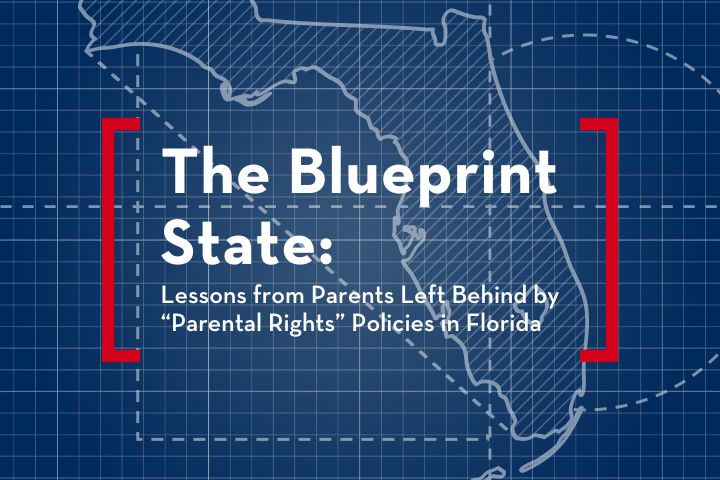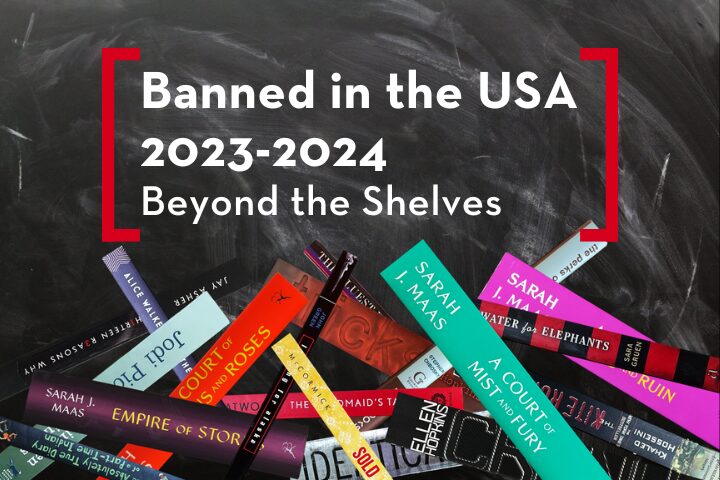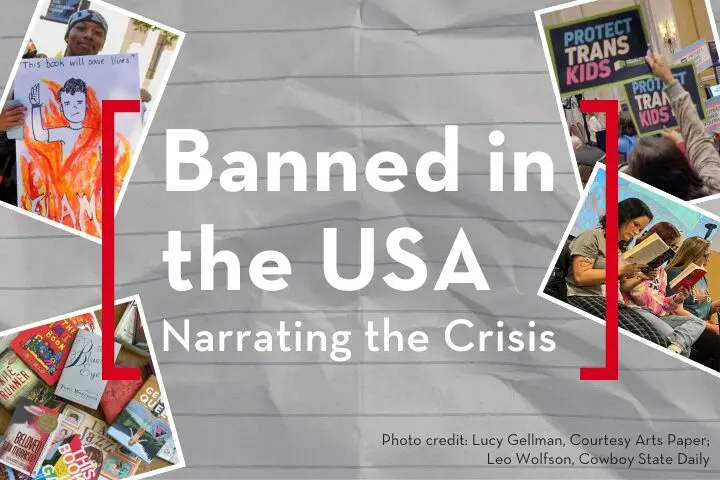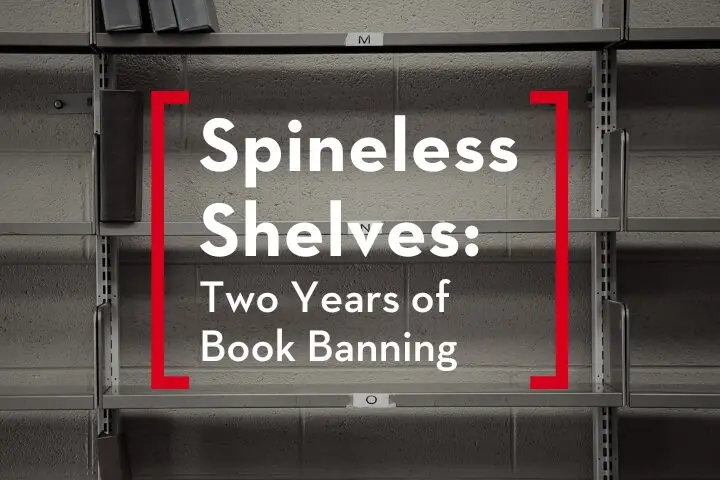Cover to Cover
An Analysis of Titles Banned in the 23-24 School Year
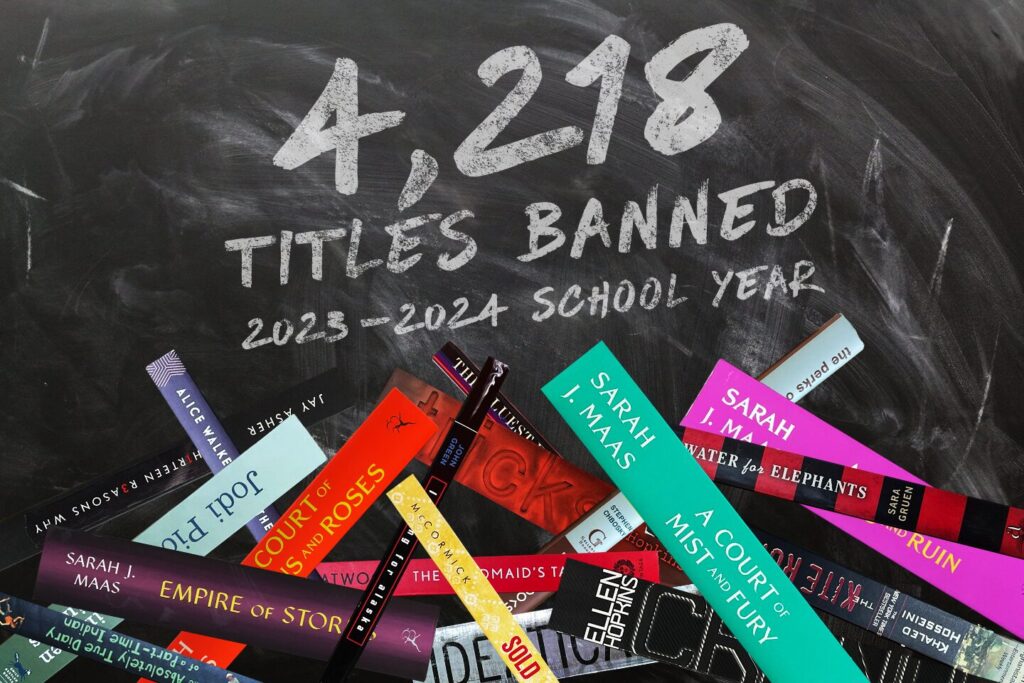
Key Findings:
During the 2023-2024 school year, 36% of all banned titles featured characters or people of color and a quarter (25%) included LGBTQ+ people or characters.
Erasure of identities is even clearer within certain types of books: 73% of all graphic and illustrated titles feature LGBTQ+ representation, people or characters of color, or discuss race or racism.
For all the inflammatory rhetoric about “explicit books,” only 13% of banned titles had “on the page” descriptions of sexual experiences.
PEN America Experts:
Program Coordinator, Freedom to Read
Senior Advisor, Freedom to Read
Senior Program Manager, Freedom to Read
Program Director, Freedom to Read
Introduction
In the 2023-2024 school year, there were more than 10,000 instances of banned books in public schools, affecting more than 4,000 unique titles. These mass book bans were often the result of targeted campaigns to remove books with characters of color, LGBTQ+ identities, and sexual content from public school classrooms and libraries. As book bans reached an unprecedented high in the last school year, PEN America sought to further understand the impacts of this censorship – the identities, content areas, genres, and types of books that are being erased from America’s public schools.
In November 2024, PEN America previously reported on the content of titles that had experienced two or more bans (1,091 titles); here, we include a more comprehensive analysis of all 4,218 titles banned during the 2023-2024 school year.
What have we found?
Book bans are not a hoax.
How do we know?
- Certain identities are being removed from library shelves en masse. During the 2023-2024 school year, 36% of all banned titles featured characters or people of color and a quarter (25%) included LGBTQ+ people or characters. Of titles with LGBTQ+ people or characters, over a quarter (28%) feature trans and/or genderqueer characters.
- Erasure of identities is pervasive within banned illustrated and graphic-heavy titles. For example, 73% of all graphic and illustrated titles feature visuals with LGBTQ+ representation, of people or characters of color, or that address race/racism. More specifically, 64% of banned picture books have pictures or illustrations that depict LGBTQ+ characters or stories.
- For all the inflammatory rhetoric about “explicit books,” only 13% of banned titles had “on the page” descriptions of sexual experiences, compared to 31% with “off the page” sexual experiences. Overall, 40% of banned titles include sexual experiences (some contained both “on” and “off the page”).
- Books banned during the 2023-2024 school year overwhelmingly address violence (65%), death and grief (55%), and abuse (43%); all very real human experiences.
Who Is Coming Off The Shelves?
As with prior years, and reflecting the overarching focus of the ongoing educational censorship movement, titles featuring characters or people with marginalized identities faced heavy censorship in public schools.

Characters or people of color
Books with characters or people of color were the most censored identity group in school book bans, and were censored across many genres and grade levels. Of all titles banned in the 2023-2024 school year, 1,534 or 36% featured characters or people of color, for example, A is for Activist, Fences, and Another Brooklyn. People of color were disproportionately affected across many categories; for instance, of all the history and biography titles, 44% featured people of color. Over a fourth of all banned historical and biographical titles (26%) featured Black people.
In 2021, the Children’s Defense Fund reported that just over 50% of young people in the United States are children of color. These school book bans are, quite literally, removing the literature that represents the lives of more than half of young people in the United States. This erasure in school libraries has deeply harmfulimpacts on the mental health of students of color.
LGBTQ+ characters or people
As with prior years, titles featuring LGBTQ+ characters or people were overwhelmingly banned: 1,066 or 25% of all titles. Of the banned titles with LGBTQ+ characters or people, 28% specifically featured trans and/or genderqueer characters or people. Further, book bans often affect titles that feature more than one marginalized identity: more than half (54%) of all books with LGBTQ+ characters or people also featured characters or people of color. Books in this category included Hurricane Child, Kiss and Tell, and Nimona.
These books are frequently accused of advancing “gender ideology” or other anti-LGBTQ+ buzzwords meant to evoke fear of “indoctrination” of children within schools. Stoking these fears has resulted in mass censorship and is creating an increasingly damaging environment for the wellbeing of young LGBTQ+ people in schools.
Characters or people who are neurodivergent or have a physical, learning, and/or developmental disability
Attacks on diverse literature have not been exclusive to titles representing LGBTQ+ people and people of color; they’re impacting all kinds of stories about inclusion and diversity. About 10% of titles banned featured characters or people who are neurodivergent or have a physical, learning, and/or developmental disability. Many of these titles also cover confidence, self esteem, or experiences with ableism.
Books in this category include Six of Crows, Ellen Outside the Lines, The Heroes of Olympus series, Anger Is a Gift, and The Tea Dragon Society. Though 10% might seem small, disabled and neurodivergent characters and people are widely underrepresented in publishing and on library shelves, which amplifies the impact of these bans.
What Kinds Of Books Are Coming Off The Shelves?
Types of titles
Following the trend from previous years, most of the titles, or 85% of the books banned in the 2023-2024 school year, were fiction titles. Fiction titles ranged from Stephen King classics to works by young adult authors like Elizabeth Acevedo and David Levithan as well as graphic novelists like Jerry Craft and Mariko and Jillian Tamaki.
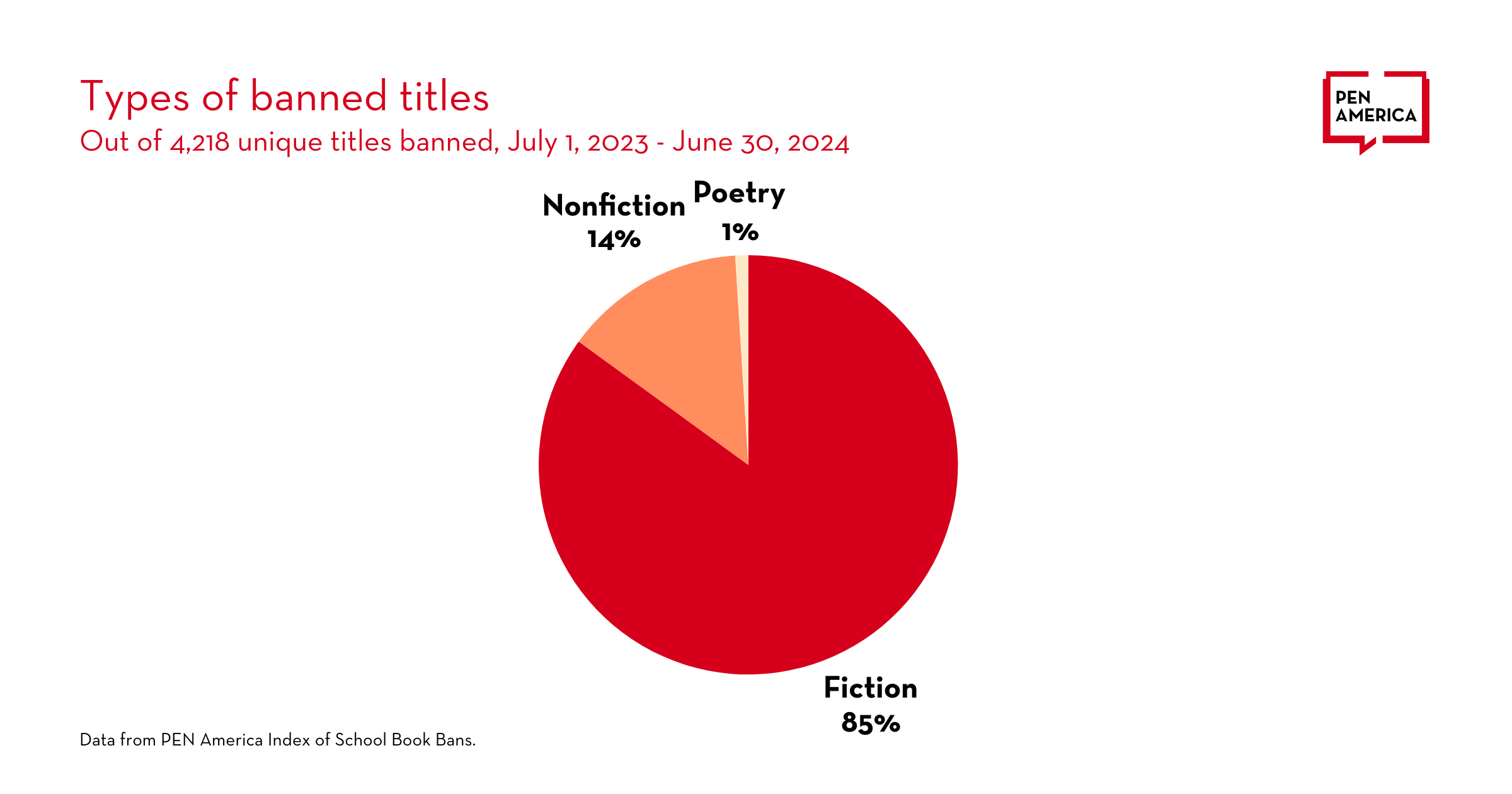
While only 14% of titles are nonfiction, that 14% includes books dealing with personal, artistic, historical, and scientific topics, such as The Immortal Life of Henrietta Lacks or Lighter Than My Shadow. This literature is essential to the growth and development of young people. Exposure to nonfiction increases students’ critical thinking abilities and provides a necessary tool in teaching about mis- and disinformation. Without this exposure, the National Council of Teachers of English states, “students are limited to a dominant view of history, which selectively erases the contributions of marginalized people and obscures the processes by which histories are composed.”
Grade levels
Most banned books (67%) are specifically intended for young adult or younger audiences.

Young adult titles often serve as the bridge to adult books, building upon teenagers’ critical thinking skills through engaging stories. Contemporary YA titles like Monday’s Not Coming or Aristotle and Dante Discover the Secrets of the Universe offer stories teens can relate to, while YA titles about dystopian or fantasy worlds like The Crown or The Rose Society can be exciting or inspiring–turning young people into lifelong readers. Young adult books challenge students’ reading skills, preparing them for more advanced titles.
While young adult titles continue to make up the majority of the banned titles, it is important to address how the availability of books across all grade levels is vital to students. Further, by examining books for specific grade levels–for example, chapter books–the impact of the concerted attack on the stories and voices of LGBTQ+ people and people of color becomes even clearer. For example, eleven banned chapter book titles were from the Who Was? series. These titles are age-relevant chapter books about historical figures and events. In the 2023-2024 school year, nine of the 11 titles banned feature illustrations with figures and stories representing LGBTQ+ people and people of color such as Who is RuPaul?.
Genres
For the first time ever, PEN America also tracked the genres that were banned in schools.
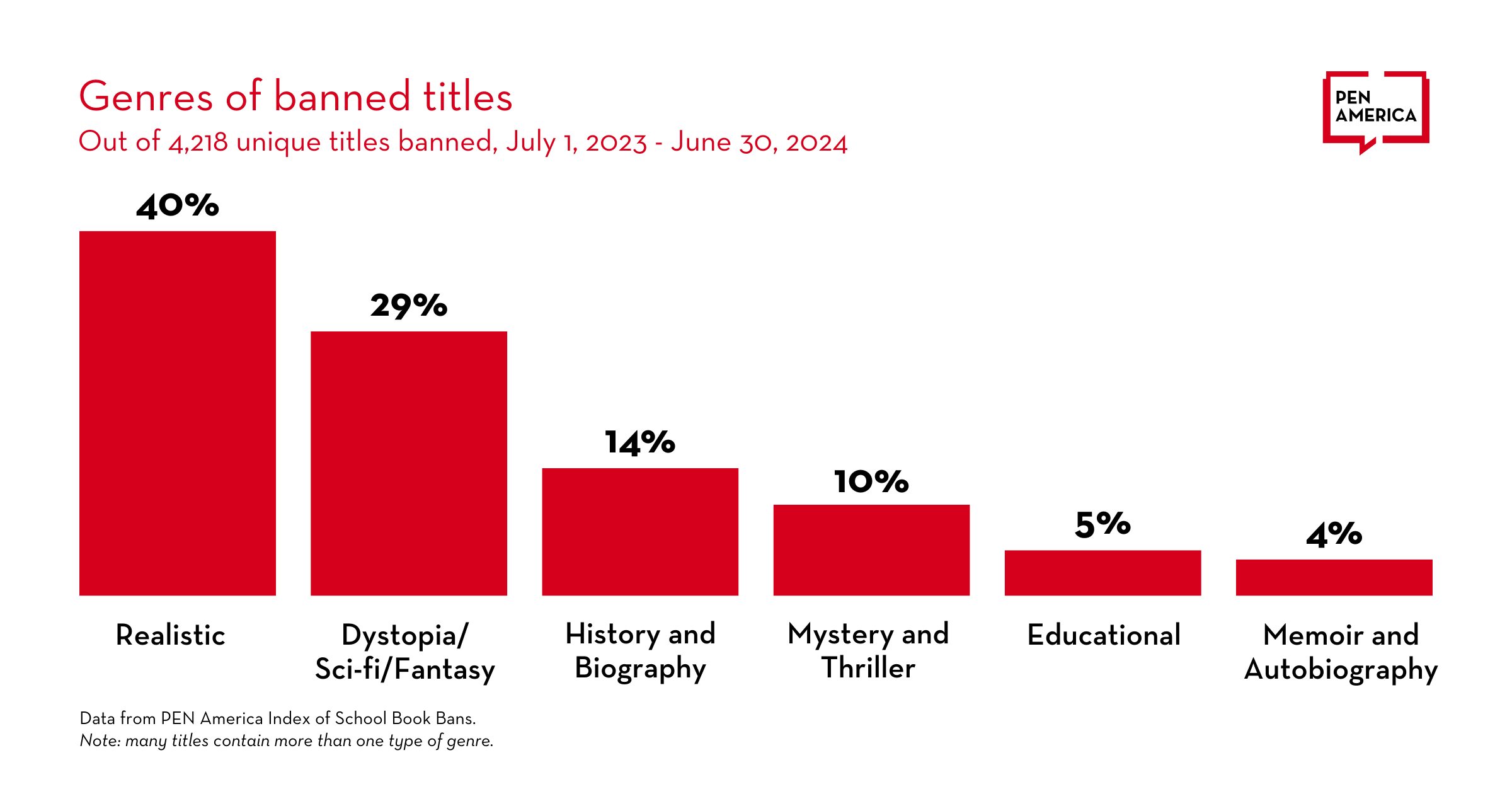
The top banned genres were realistic fiction, dystopia/sci-fi/fantasy, history and biography, mystery and thriller, and educational. Realistic books show students the world around them; dystopia/sci-fi/fantasy can often do the same, through metaphors and imaginative depictions. In her book, The Magic Words, children’s book editor and author Cheryl B. Klein explains that “in the modern era, many of the best fantasies for children and young adults use magic to externalize an emotional or societal situation and examine or solve it thoughtfully.”
The outsized number of banned memoirs and autobiographies featuring the personal narratives of people of color and LGBTQ+ voices provides more evidence of a concerted movement to censor these stories – and erase them from public school education and libraries. Of the 159 memoirs and autobiographies banned, 25% (39 titles) feature LGBTQ+ people, 9% (14 titles) feature trans and genderqueer people, and 44% (70 titles) feature people of color. These bans remove the voices of contemporary figures from young people–the voices of people who reflect their identities or can increase understanding of differences.
What Pictures Are Coming Off The Shelves?
There has been one “kind” of book that has dominated discourse about book removals in school libraries over the last three years: books with pictures. Like genre, the analysis of graphics and illustrations in banned titles is new as of this brief.
Seventeen percent (17%) of all banned titles during the 2023-2024 school year included graphic or illustrated content. Of those titles, most (60%) had illustrations related to race and racism or featured characters of color. Other common visuals in banned illustrated or graphic titles include LGTBQ+ themes and characters (39%), violence or gore (30%), and political or social movement messaging (11%). Non-sexual nudity (17%) and sex-related nudity (18%) were banned at a similar rate.
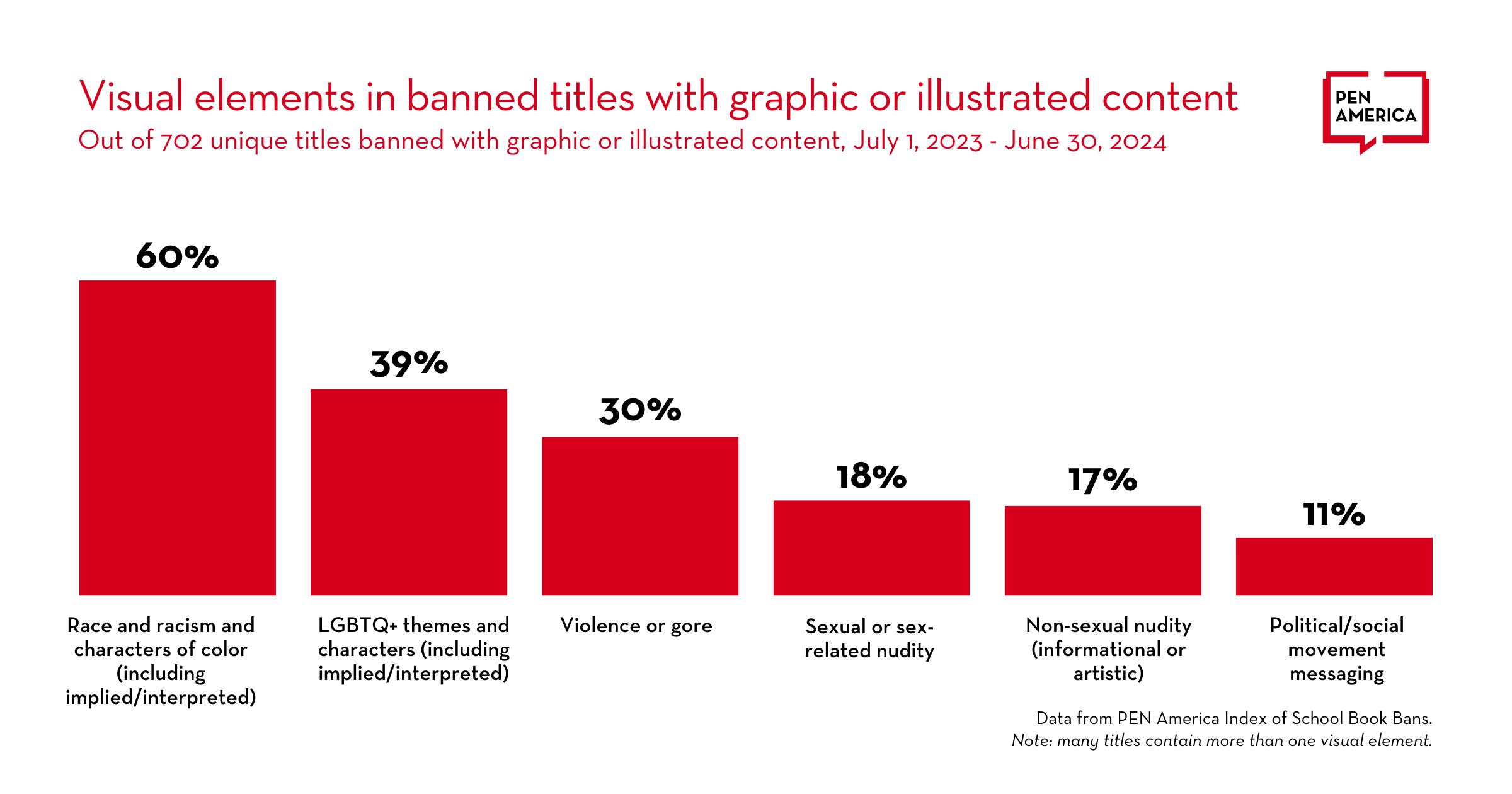
Picture books, comics and graphic novels, and art books are largely being banned through “context stripping,” when a few panels or images are examined without any regard to the context of the excerpt or the book as a whole, and then used to determine if the book is “appropriate” for students or not.
Book bans on graphic and illustrated works have removed award-winning and popular titles from public school classrooms and libraries, including comics and graphic novels like Gender Queer; picture books like The Family Book; manga series like Assassination Classroom; and titles covering art or nonfiction topics, like 100 Women Who Made History: Remarkable Women Who Shaped Our World.
The targeting of illustrated or image-heavy books echoes their history of censorship in the United States, such as the Comics Code created in the 1950s that effectively sanitized and eradicated genres like horror and sci-fi in comics and erased LGBTQ+ characters from comics for decades.
There’s something about pictures. Pictures go straight into your brain, you can’t block them, right through your eyes. You see it, you can’t unsee it. … Unlike a movie, comics stand still. So you can look at a picture that some school board that never read the book pulls out of context, and says “kids are seeing this!” They are seeing it, they may even look at it longer, they may have questions about it. Better that those questions get dealt with, and that’s the job of schools.
— Art Spiegelman, author of the banned graphic novels Maus I and Maus II
A closer look at picture books
One format of “books with pictures” includes picture books. As noted above, 2% of all banned titles are picture books; and nowhere is the attack on stories of LGBTQ+ children and families more apparent than in this format. Balancing text and illustration for a variety of readers (and non-readers), picture books are an extraordinary art form and fundamental resource for emerging literacy in the youngest of students.
But these picture books, no matter how wholesome, continue to anger book banners. Around 64% of all picture books banned have LGBTQ+ characters or stories. This includes metaphors that foster acceptance and empathy like Red: A Crayon’s Story, stories of young LGBTQ+ people like My Rainbow, and stories of LGBTQ+ families like Stella Brings the Family. For more than 5 million U.S. children with an LGBTQ+ parent, their families are being removed from shelves. The attack on these picture books is a clear effort to erase LGBTQ+ families and students from the sphere of understanding of young children.
What Topics Are Coming Off the Shelves?
As wonderful as books themselves are, the topics they deal with extend to both the best and worst parts of the human experience. For example, explorations of sexuality can feel intimidating but exciting. Other topics, such as violence, abuse, death, and grief can be difficult for students but will undoubtedly affect them at some point in their lives. Books–especially those selected by professionally-trained school librarians–offer students the language, context, and support to feel seen and supported through these ups and downs.
Sex-Related Content
Sex-related content is one of the most commonly discussed and criticized subjects in books in school libraries today. The two states with the most school book bans last year–Florida and Iowa–both have legislation that, in part, targets books that include sex-related content.
Around 43% (1,817) of all banned titles contained some kind of sex-related content. Of the titles with sex-related content, 92% depicted consensual sexual experiences, 11% had abortion and teen pregnancy, and 10% featured sexual education. Titles banned within this category include Forever…, Sex is a Funny Word: A Book About Bodies, Feelings, and YOU, and With the Fire on High.
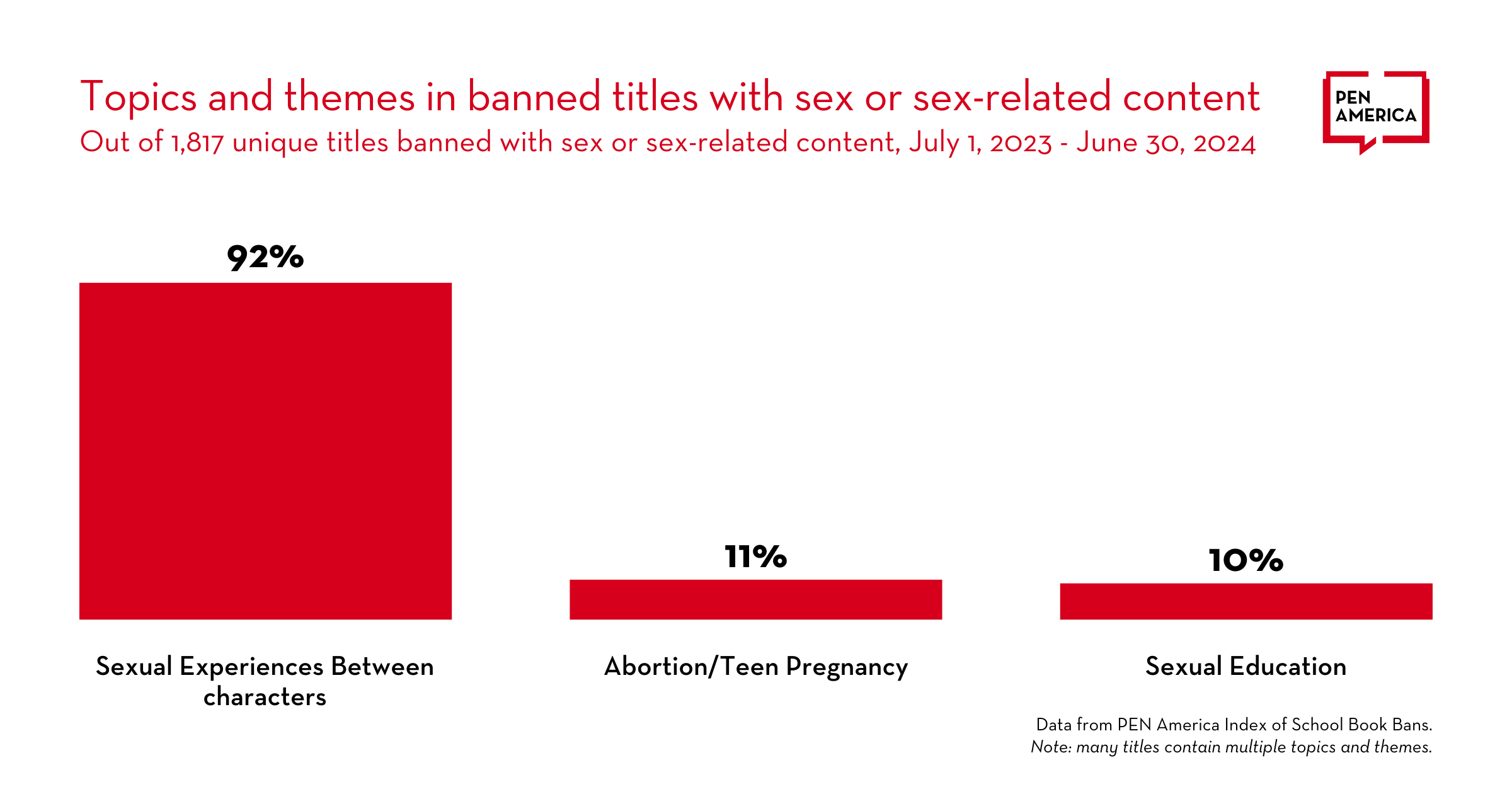
For all the supposed panic about sex in books, interestingly, the majority of books with sexual experiences between characters did not even feature sexual scenes “on the page.” Books with “on the page” sexual experiences between characters contain more descriptive scenes of sex between characters. This is distinguished from “off the page” scenes that imply sex but do not describe it directly, taking a “fade to black” approach instead. Some titles contain both on and off the page sexual experiences. Out of all 4,218 unique titles banned in the 23-24 school year, 13% had on the page sexual experiences and 31% had off the page sexual experiences (some contained both “on” and “off page”).
Of the banned titles in the 23-24 school year,
31% had “off the page” sexual experiences
13% had “on the page” sexual experiences
While those attempting to ban books in schools often label all books with consensual sexual experiences to be outright “explicit,” those claims are exaggerated rhetoric.
Books with either on or off the page sexual experiences should not be reduced to being evaluated for those scenes and pages alone. These books overwhelmingly address important topics such as consent or pleasure–teaching young people about their bodily autonomy is important, as is modeling what healthy relationships can look like.
Non-Sexual Violence
Books addressing non-sexual violence comprised 60% of all 4,218 banned unique titles in the 23-24 school year. These titles spanned a wide array of topics, addressing difficult subjects such as war, gun violence, slavery and genocide, physical fighting, and more. The three most prevalent themes of violence include: physical fights and physical assault (74%), physical abuse (44%), and warfare violence (23%).
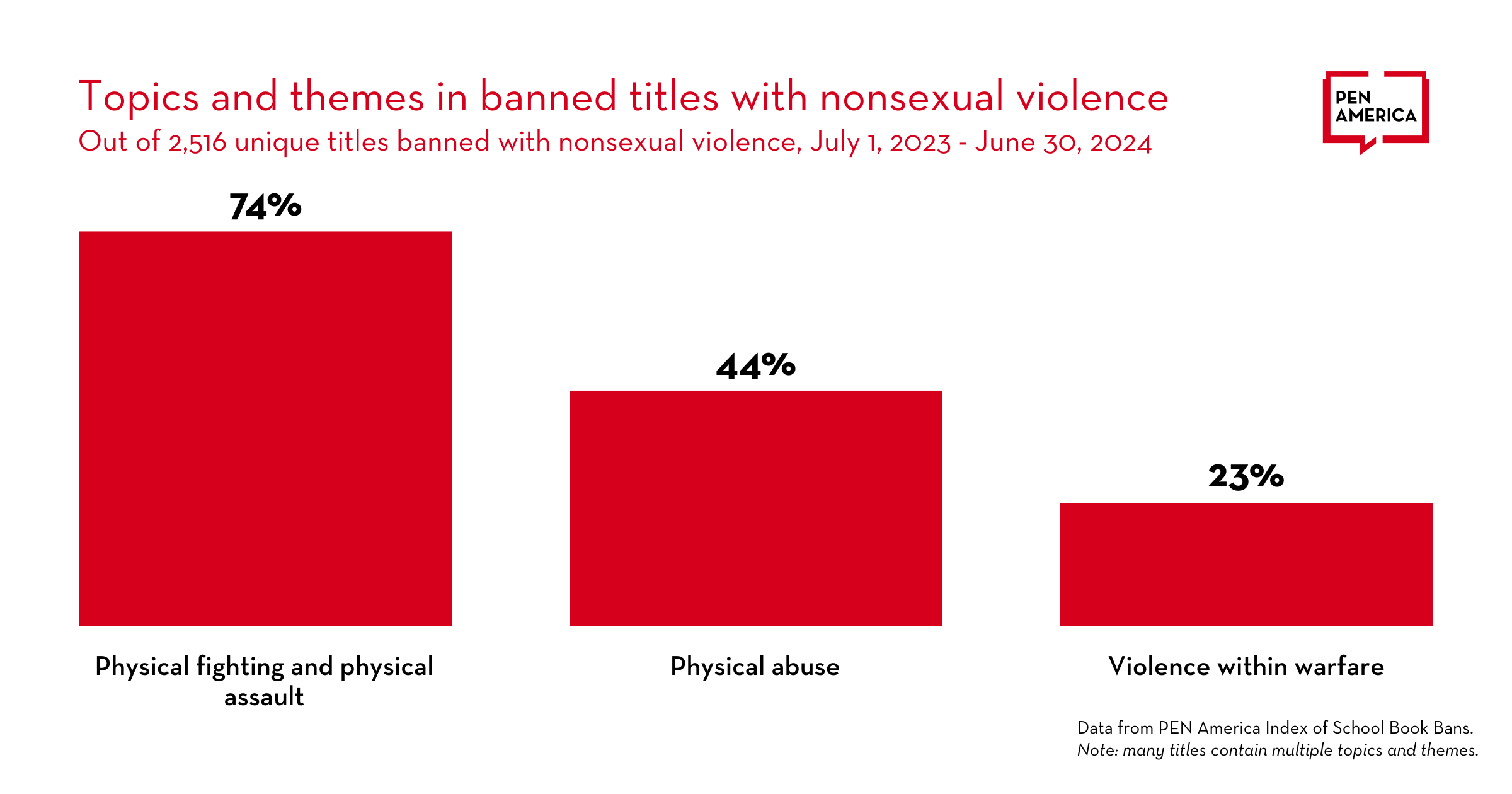
Popular and award-winning banned books in this category include Anne Frank’s Diary: The Graphic Adaptation, Educated: A Memoir, and The 57 Bus. Book banners often claim books with violence are too graphic for young people who might be influenced by the content. However, research has shown that exposure to violent content by itself does not inherently cause individuals to commit violence.
Sexual Assault and Sexual Violence
In the 2023-2024 school year, 23% of all banned titles contained sexual violence. Of the titles with sexual violence, 88% had sexual assault or rape, 28% contained sexual abuse, 10% contained incest, and 10% contained statutory rape. Titles featuring forms of sexual assault and/or sexual violence include Damsel, Silent to the Bone, and Boy Toy.
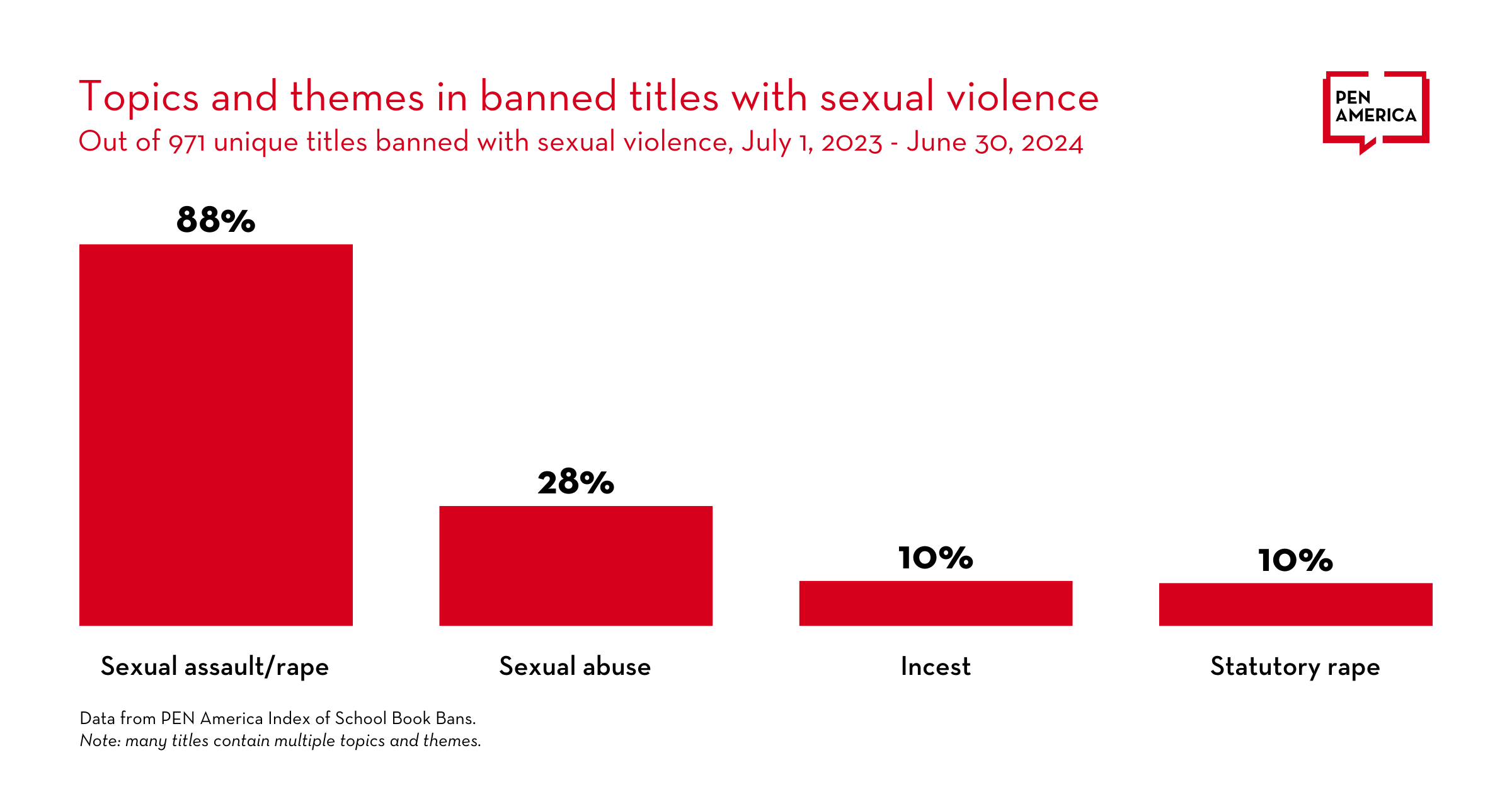
Disturbingly, these titles are frequently censored with accusations that they are “pornographic” and devoid of any literary merit. There is nothing “pornographic” about sexual violence, nor about many books that powerfully depict it.
Author Karen Jensen reported one teen’s response about reading these topics: “the only thing that made me uncomfortable with this topic was that these fictional stories are something that is happening daily to real people.” Despite the claims from some who want to ban these books, these titles depict real-world situations that anyone–including young readers–can and do experience.
[Parents who censor books] think they’re shielding their children; what they’re actually doing is they’re making their children more vulnerable. And they’re making all the kids in their community more vulnerable, despite the wishes of other families.
— Laurie Halse Anderson, author of Speak and Shout
Abuse
The topic of abuse in the titles represented in the index is varied across physical, sexual, and verbal violence. Of all titles banned, 43% had at least one form of abuse featured within the plot or addressed informationally. Of the banned titles depicting abuse (1,830), the most common theme is verbal and emotional abuse at 71%, followed by physical abuse at 60%, and sexual abuse at 15%.
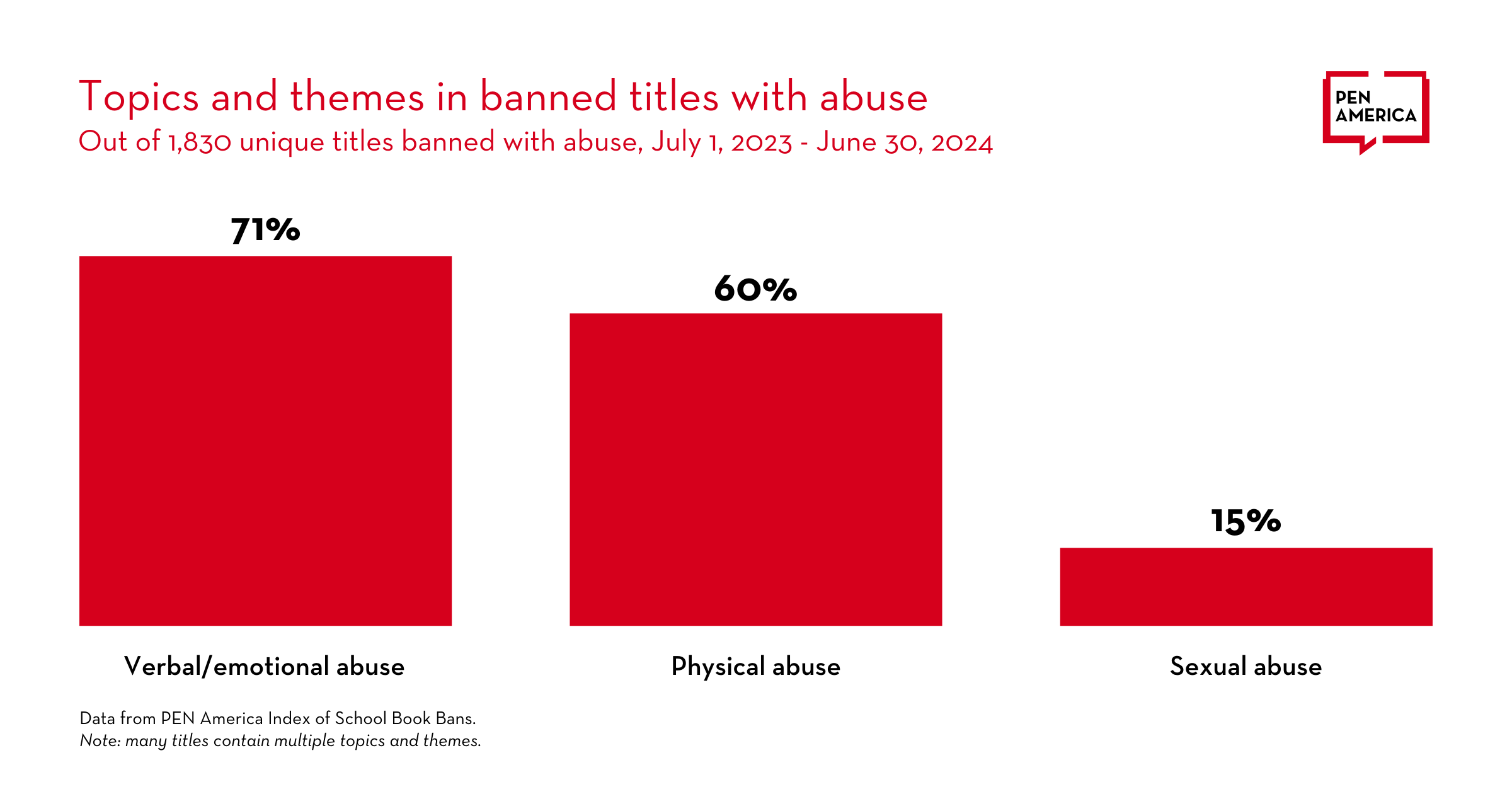
Banned titles featuring abuse include The Sun And Her Flowers, Unravel Me, and The Color Purple. As has been mentioned above, these titles can serve as a resource for young people to recognize the warning signs of abuse, understand harm they may have experienced in their own past, learn to be an active bystander, or feel less alone.
Religion
Of the titles banned in the 23-24 school year, 14% (603) contained religion as a topic or component of the plot. Of these books, the majority (87%) featured a significant religious character or person. The majority of titles with a religious character or person were Christian, Muslim, or Jewish.
Banned titles featuring religion and spirituality included The Purim Superhero, To Night Owl From Dogfish, and When You Trap A Tiger. And, of course, The Bible.
Mental and Physical Health
Books with difficult, real-world topics often cover subjects that relate to young people’s mental and physical wellbeing. Substance use and/or abuse was a theme in 30% of all banned titles and mental health in 33%. The largest category, however, were titles with themes of death and grief with 55% of all titles.
Topics that feature mental and physical health
Out of 4,218 unique titles banned, July 1, 2023 – June 30, 2024
| Death/Grief | 55% |
| Mental Health | 33% |
| Empowerment/Self-Esteem | 31% |
| Substance Use and/or Abuse | 30% |
| Bullying | 22% |
| Suicide | 16% |
Titles banned featuring these subjects include Spinning, Firekeeper’s Daughter, Finding Junie Kim, and Hold Still. Not every young person’s family wants or is able to take the time to discuss these important subjects with their child, making access to titles with these topics incredibly important to support young people’s development and understanding of the world.
Social and Societal Topics
Similarly, social and societal topics, including immigration, police reform, or activism more generally, have increasingly been a hot button issue in all of education. Of all banned titles, 15% contained themes of activism and social movements; 13% depicted incarceration or negative interactions with police; 7% included immigration and refugee stories; 20% included LGBTQ+ themes or metaphors; and 20% covered race and racism. These themes are distinct from the identities noted above. Banned titles include Young Palestinians Speak, Something Happened in Our Town, and Wishtree.
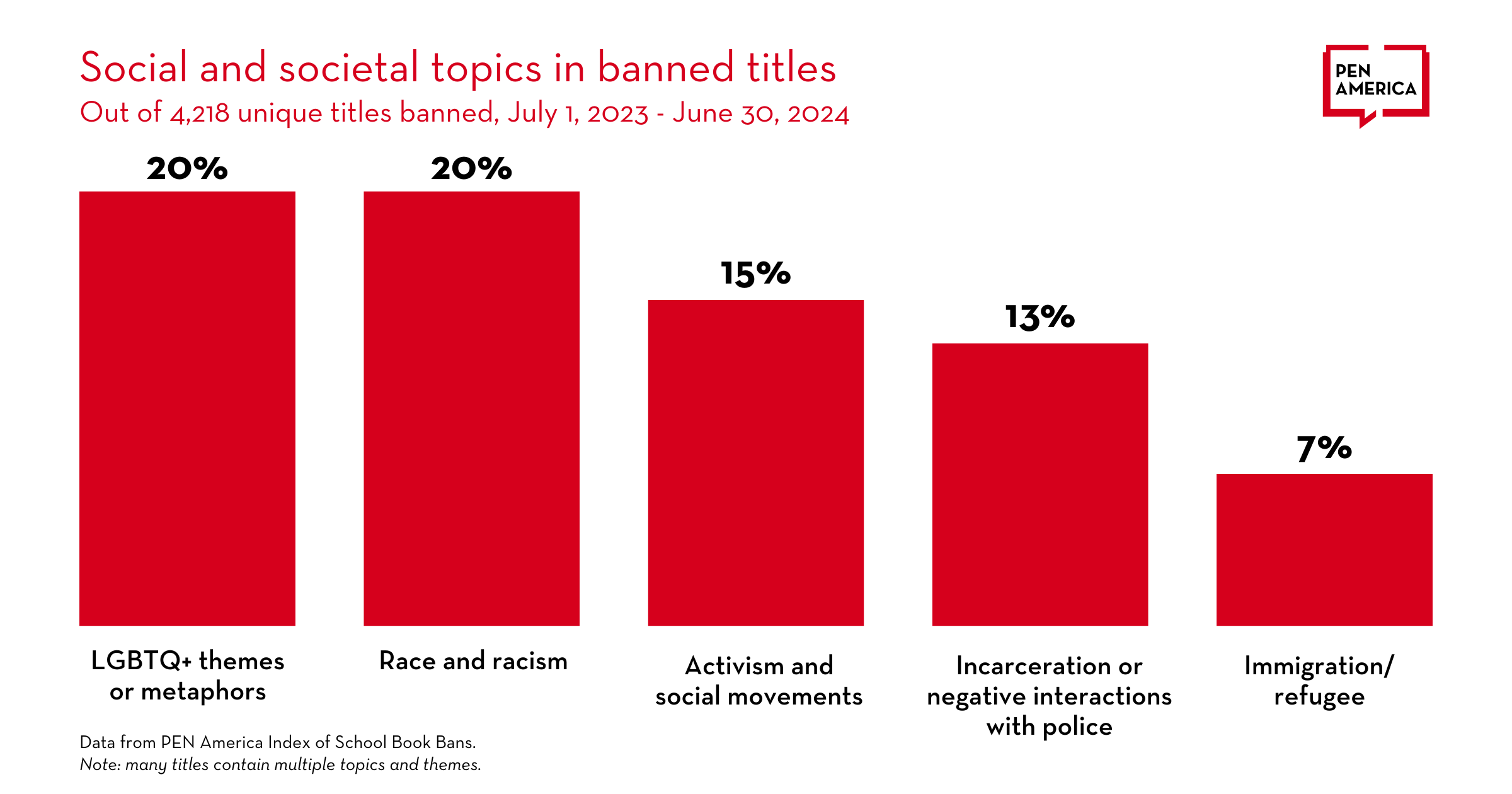
Books about these topics share real and fictional stories about the world in which we live; from social movements that have fought to improve society, to the impact of police violence on communities. These books also serve young people by increasing their understanding of issues like racism or homophobia.
Removing these titles from shelves fails to create a library representative of the world that young people are a part of. An estimated 5 million U.S. children have had a parent incarcerated at some point in their lives. An estimated 17.6 million U.S. children are part of immigrant families. Everyone deserves to feel seen and represented in their library.
By banning books, you are silencing the voices for the people who don’t have one. A lot of students may be able to see themselves within the books and feel seen, heard, validated, and not alone. If students don’t know about issues, they are bound to be brought up into one themselves.
— Naomi, Panther Anti-Racist Union student activist
Again, It’s Not A Hoax
In January of 2025, in addition to official claims that book banning is a “hoax,” President Trump signed an executive order titled “Ending Radical Indoctrination in K-12 Schooling.” Riddled with dog-whistles and disinformation, the consequences of this bill are already being seen: Department of Defense schools have been removing books en masse from shelves and schools across the country are changing their curriculum and policies. Like the book bans we have seen the last three years, this Executive Order is targeting trans youth, culturally responsive education for all students, and content representing people of color and LGBTQ+ people.
Book banning is not a hoax. And it’s not new either. Bans of LGBTQ+ books echo Anita Bryant’s anti-gay crusade of the 1970s, while censorship of books about activism and social movements parallel McCarthyism. Bans of books on sex-related topics echo that of Anthony Comstock, and bans of books on race and racism echo the Reconstruction-era and post-Brown v. Board of Education textbook censorship. Literary censorship is a hallmark of a move to more authoritarian and fascist regimes – but we still have time to learn from this history, even as book banners try to erase it from schools.
Today’s book banning phenomenon is not incidental: it’s the result of a well-funded campaign to dismantle public education, backed by a coordinated network of groups that largely espouse white supremacist and Christian nationalist ideology. Resources created by these groups, such as BookLooks or Laverna in the Library, provide those wishing to ban books a tool to target the very topics our analysis has identified as overwhelmingly banned. When so many young adult, young reader, and classic novels are banned, is it believable that these removals are simply about what is “age appropriate”?
But as the number of bans grow, so does the movement to resist it. Hope can be found in the increasingly brave and growing movement to defend libraries from book bans. People from all walks of life are standing together to protect libraries from those who seek to empty them. These dedicated students, parents, librarians, educators, and concerned citizens are empowered by a love of books and an appreciation for diversity, inclusion, and knowledge. Those values are something that cannot be silenced by a book ban.
When we deplete shelves of diversity and strip them of books depicting real history and the world around us, we defeat the purpose of school libraries to fulfill the diverse needs of students within each and every public school. These bans occur under the guise of “parental rights” but are, in reality, an attempt at controlling information. Affirming students’ rights is of the utmost importance in addressing this issue, because ultimately, they will inherit our future.
Methodology
PEN America collects separate counts for instances of bans and unique titles. In the 2023-2024 school year, we recorded 10,046 instances of school book bans. Unique titles refers to individual titles banned; one title can be banned just once or dozens of times across multiple districts. The data presented here is based on the unique titles banned, rather than all cases. For more information about our standard methodology and definitions, please visit our 2023-2024 report, Banned in the USA: Beyond the Shelves, our frequently asked questions page, and the PEN America Index of School Book Bans – 2023-2024.
For the analysis of banned titles’ content presented in this report, we looked at the 4,218 unique titles extracted from our Index of School Book Bans that recorded 10,046 book ban instances during the 2023-2024 school year. Using a team of staff researchers, expert consultants, and author volunteers, each unique title was reviewed across 37 variables, primarily the type of book (e.g. genre, age level) and content within the title (e.g. LGBTQ+ characters or people, sexual experiences between characters). Final coding was reviewed, cleaned, and analyzed by PEN America’s research team. For additional information on our content analysis methods, please visit our frequently asked questions page.
A small reduction (13 titles) from our count of unique titles banned initially reported (4,231) occurred in the process of analysis due to incidental duplicates. This did not impact the total number of cases we have reported (10,046).
Acknowledgments
This report was written by the Freedom to Read Program experts Madison Markham, program coordinator, and Tasslyn Magnusson, PhD, senior advisor. Report writing and data collection was reviewed by Sabrina Baêta, senior program manager and Kasey Meehan, program director. The report was reviewed and edited by Jonathan Friedman, Sy Syms managing director, U.S. Free Expression Programs.
This report builds upon the information reported in our 23-24 report, Banned in the USA: Beyond the Shelves, Both this brief and the Beyond the Shelves report would not be possible without support from several PEN America colleagues and external consultants. Critical support for data collection and analysis was provided by PEN America’s Daniel Cruz, Hanna Khosravi, and Sarah Dillard; external consultants, Octavia Driscoll, Sanobar Chagani and Dominique Baêta; and Nicole Moses and Nikki Gallant, student interns for the Freedom to Read Program.
This brief details a comprehensive analysis of the content and themes present in banned books. We thank the following volunteers for providing key support in coding the content and themes of banned titles: Dani Behonick, Katryn Bury, Tobias Carroll, Shirley Chan, Cristina Deptula, Patricia Elzie-Tuttle, Ellen Gidaro, Mars Hauser Hage, Samantha Mills, John Odell, Susanne Pari, Lauren Parker, Keely Parrack, Maria Ramos-Chertok, Paula Schaap, Esq., Lori R Snyder, Lara Starr, Pamela S. Turner, Audrey Vernick, Erica Lorraine Webb, Mindy Weisberger, Khan Wong, and Ann Zhao, as well as several other experts who did not wish to be named publicly.
Geraldine Baum, chief communications officer, oversaw production of the report and Suzanne Trimel and Lisa Tolin supported its release. We thank the entire Communications team at PEN America for their support of this work.
PEN America is grateful for support from the Endeavor Foundation, The Spencer Foundation, Henry Luce Foundation, and the Long Ridge Foundation, which made this report possible. We also thank key partners in this work, including Authors Against Book Bans, the Florida Freedom to Read Project, the Texas Freedom to Read Project, and Let Utah Read.
Finally, we continue to extend our gratitude to the many authors, teachers, librarians, parents, students, and citizens who are fighting book bans, speaking out in their communities, and raising attention to these issues. We are proud to stand with you in defending the freedom to read.





